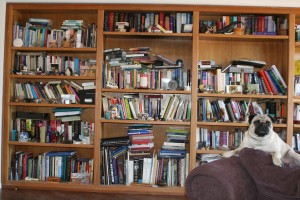
I get a lot of questions about what I read, what resources I find "useful," how much research I do, etc., etc. And when interviewers come to talk to me at home, they always want to see my office, and frequently spend half an hour or more browsing my bookshelves in fascination. So I thought y’all might want to have a peek, too.
(One question I often get is about how I organize my material. It is to larf, as John Lennon so eloquently put it. I have two—no, three—ways of organizing research material. The books live in bookshelves. Loose papers, maps, reprinted emails, etc. go into one of three zippered… things. (I can’t really describe them; they’re about the size of small briefcases, but made of nylon fabric, mesh on one side, and they zip on three sides.) The red one holds all the printed miscellanea for the contemporary mystery that I’ll eventually get round to finishing, the black one has stuff about the Lord John stories’ background—maps of London, a guide to the geology of Jamaica, that sort of thing—and the blue one has Stuff that might at some point be useful to the Big Book— MOBY, at the moment— under construction. Interesting websites and material people email me ends up either as a site bookmark or in a catch-all folder/directory called "JRESRCH.") And, um… that’s about it, really.
I do group books among and within bookshelves, though. This is a small office, so there are only two sets of shelves up here: the huge, built-in set of four bays that my husband got me for an anniversary present in 1993 or so, and a much smaller one that got added during a renovation a couple of years ago. Downstairs, in the lower office, two walls are lined with built-in shelves, but a lot of those books are the family "core" library—classics and series that anybody might want to read anytime. (It has got my collection of ghost stories, the field guides, and the natural history references, too, though.)
Anyway, it’s the big bookshelf in my upper office that mostly fascinates people, so I thought I’d show you that, for starters. Above is the overview, guarded by Otis (my son’s pug, who visits often and likes that chair).
And here’s a closeup of the top shelf, upper left:
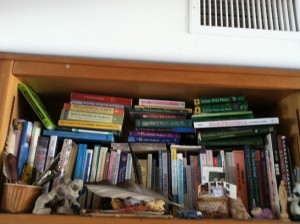
This is the larger part of my collection of herbals (which continues on to the next shelf). You’ll note that I plainly need a third (and possibly a fourth) shelf for these, but there’s no place to add more up here. I need to weed through these, and move the less-useful references out to one of the tertiary bookcases in one of the (adult, moved-out) kids’ bedrooms.
The books in this class that are/have been most useful are generally the field guides, which tell me where things grow, which plants are native and which are introduced species, which are edible, poisonous, or medicinal. THE PETERSON FIELD GUIDE TO MEDICINAL PLANTS, Eastern/Central region is the main guide to American herbs, while the Hamlyn GUIDE TO MEDICINAL PLANTS OF GREAT BRITAIN is… well, the British equivalent. Both of these books have indices that include diseases and symptoms, with listings for which herbs are or have been used for treatment of same.
Mrs. M. Grieves’ A MODERN HERBAL (published in 1931; the edition I have is an unabridged 1971 Dover reprint) is a much more detailed and more scholarly reference that includes the chemical analyses of many plants’ active principles, as well as historical and cultural notes on usage. The illustrations are not of the quality you’d find in a more modern production, being mostly line-drawings, but still helpful.
Nicholas Culpeper’s CULPEPER’S COMPLETE HERBAL (published in 1647) is the oldest one I have; less directly useful, but still interesting to see just how far back some of the common herbal medicines were known, as well as to see the theoretical/philosophical basis underlying some of the treatments.
And Paul Beyerl’s THE MASTER BOOK OF HERBALISM gives a thumbnail of each of many commonly useful herbs, with preparation and treatment details—but does so from a Magickal point of view, including information like the phases of the moon and how to use certain herbs in conjunction with various gem stones. (You’ll notice that the few gem magic books I have are also mostly in this section.)
As for the inspirational artifacts… <g>
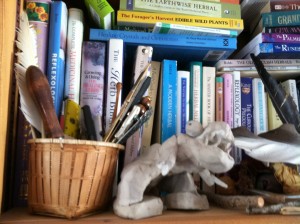
Moving from left to right:
Basket full of letter-openers. In practice, I usually open letters with a steak-knife (or a pair of poultry shears, for particularly intransigent parcels), as I’m generally reading the mail at the kitchen table. Kindly intentioned people often give me letter-openers (and very beautiful hand-made bookmarks, which—alas—I don’t use, either. If reluctantly compelled to stop reading a book, I normally set it face-down, open to the page I abandoned), though, and I also inherited a couple of these from my father, who didn’t use letter-openers, either, preferring a thumbnail, but kept an ornamental one on his desk for show.
 Ferocious dinosaur, made by my son, aged about six at the time. (He’s now 28 and a published novelist in his own right. Sam Sykes, esteemed author of THE TOME OF THE UNDERGATES, BLACK HALO, and— coming in September from Pyr Books (US) and Orion (UK)—THE SKYBOUND SEA.)
Ferocious dinosaur, made by my son, aged about six at the time. (He’s now 28 and a published novelist in his own right. Sam Sykes, esteemed author of THE TOME OF THE UNDERGATES, BLACK HALO, and— coming in September from Pyr Books (US) and Orion (UK)—THE SKYBOUND SEA.)
Sticks. Mind, these are not just any old sticks. They’re twigs from a silver birch tree, growing on the edge of Alamance Creek in North Carolina. I picked them up during a brief research trip, and used them to evoke the whole sense of vegetation, atmosphere, and weather in parts of THE FIERY CROSS.
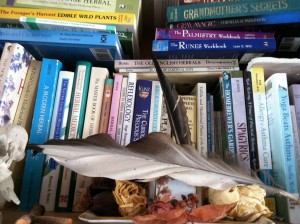
Replica of an 18th-century ink-well and tray, given to me by a good friend, John L. Myers (also a writer—of gay crime fiction (the novel HOLY FAMILY), as well as daily prayers and contemplations (at www.sacredpauses.com)). The quill in the inkwell is a raven’s wing-feather (the original goose-quill that came with the inkwell is over in the basket with the letter-openers), and the very large feather is—I think; I lose track of which feathers came from where (this is another thing people give me fairly often, but I do actually use them)—from a golden eagle, given to me in 1974 by a friendly zoo-keeper (now deceased) at the San Diego Zoo (I was doing a small research project there); it came from one of the captive birds at the zoo. If that’s not what it is, it’s a turkey feather.
The tray is filled with dried roses. Each of my daughters, at some point in her adolescence, gave me roses. I kept them.
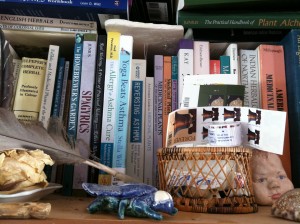
The small ceramics of the housefly, the panda and the chubby baby’s head were gifts made by my sister—the baby was done from a notorious photograph of my son; the one the family refers to as "you know, the one of Sam as Mr. Potato-head…."
The small basket is full of stamps, though I find that I seldom need one anymore, in these days of ubiquitous emails and the Invaluable Susan, the assistant my husband and I share, who hauls anything outgoing over to the mail-place.
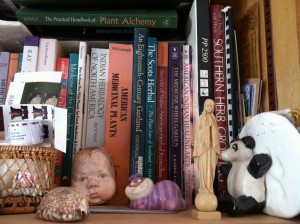
The little statue of the young Virgin was given to me in 6th grade, as a classroom prize of some kind. I was a confirmed teacher’s pet through high-school. Not very popular, as one might expect.
The white unfired ceramic is a memorial paw-print, sent to me by the kindly people at the animal hospital after my first beloved dachshund, Gus, died. [Below are the present incumbents, Homer and JJ, who also like the office chair and ottoman. (Photo of my pups taken by Loretta, my Webmistress.)]
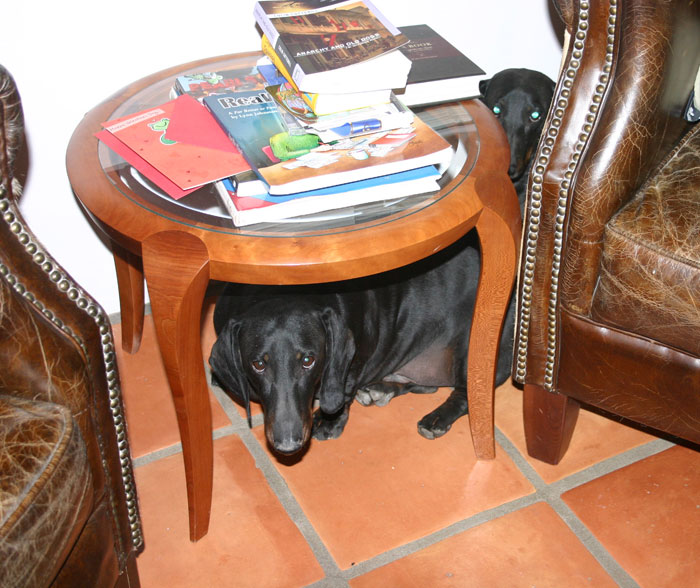
My husband gave me the Disney Cheshire Cat as a souvenir of a family trip to Disneyland.
And the things over to the right are the sort of little bags that people put small gifts of jewelry, scented oil, or knicks-knacks in. I keep thinking they’re bound to be useful one of these days.
Return/go to my Writer’s Corner (What I Do) webpage.
This page was last updated on Thursday, October 25, 2018 at 3:40 a.m. (Pacific Time) by Diana’s Webmistress.
Thanks Diana for sharing your Bookshelf – which is very private! Made me smile – funny that I always find my books when the shelfs are “growing by themselfes”. As soon as I start Clearing and cleaning and sorting….. nothing is found anymore ;-)))))) Thanks for your tremendous books! Kindest regards from Austria! Helga
Dear Diana,
I feel considerable less about my bookshelves since I’ve seen your!
Be safe!
M Teresa
Just finished “go tellthe bees that I have gone”—love all the books—can hardly wait for the next book and the next episodes.
Hi, Barbara,
So glad that you enjoyed BEES and are looking forward to Book Ten in my Outlander series of novels, and for Season 7 of the Outlander TV series.
Thanks,
Diana
Dear Diana,
I am back to reading book #1 for my third time, reading the entire series !!! I just finished “Go Tell the Bees I’m Gone” and realize again how rich, stimulating, true to life your writing world is !!!
I first read Outlander when it was published in 1993 and knew I had read something special but never imagined I would still be looking forward to your next “take on the 18th Century” still today.
You make men and women come alive in your stories, and I’ve often told friends, “It’s amazing how well you develop men and masculine characteristics. Jamie, Murtaugh, Roger, Ian and Lord John are REAL PEOPLE to me who just happen to live in the 1700′s. I suspect William will come round as well in book number 10 ???
Of course, Claire is the best developed female, to me, but I would expect you to be able to know about women…but your portrayal of masculinity is astonishing to me.!!!
Geri Disnard
But of course, you know that you are an incredible writer. I suppose all of your attempts at acadamia pre-, and present have been remarkable. Not to sugarcoat it but I have read a lot of books. I wrote a couple of my own, and with that said I have never read a writer as good as you. That includes JRR Tolkien.
Incredible. I can’t wait for Outlander book 10, perhaps you may name it, from the ridge to the bridge, whatever that would be. I think you for the adventure.
D. Owen Powell
Please write #10 as quickly as possible, I’m 80! Thank you for your wonderful, lovely, minutely researched books.
Joan Townsend
Diana turned 71 years old on January 11, 2023…
Diana:
Firstly, I love your books! You are right up there with Charlotte Bronte and George Eliot, for me. Secondly, I love your shelves. I’m a history professor and mine look just like yours. I have a pug dog. Would be interested in what novels you read!
Hi, Teresa,
Diana reads a LOT of books. As to those she likes a lot and recommends to readers, some are listed on her Methadone List under the Resources menu:
https://dianagabaldon.com/wordpress/resources/the-methadone-list/